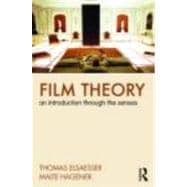
| Acknowledgments | p. vii |
| Introduction: film theory, cinema, the body and the senses | p. 1 |
| Cinema as window and frame | p. 13 |
| Rear Window | |
| Constructivism | |
| Realism | |
| Open and closed film forms (Leo Braudy) | |
| Classical cinema | |
| Central perspective | |
| Rudolf Arnheim | |
| Sergej Eisenstein | |
| André Bazin | |
| David Bordwell | |
| Cinema as shop-window and display | |
| Cinema as door - screen and threshold | p. 35 |
| The Searchers | |
| Entry into the film | |
| Etymology of screen | |
| Thresholds of the cinema/movie theater | |
| Beginnings: credits and credit sequences | |
| Neo-formalism (Bordwell/Thompson) | |
| Post-structuralism (Thierry Kuntzel) | |
| Michail Bachtin | |
| Door/screen as filmic motif in Buster Keaton and Woody Allen | |
| Cinema as mirror and face | p. 55 |
| Persona | |
| Béla Balázs | |
| The close-up | |
| The face | |
| Face as mirror of the unconscious | |
| Christian Metz | |
| Jean-Louis Baudry | |
| Apparatus-theory | |
| Early cinema and the close-up (Tom Gunning) | |
| Reflexive doubling in modern (art) cinema | |
| Mirror neurons | |
| Paradoxes of the mirror | |
| Cinema as eye - look and gaze | p. 82 |
| Blade Runner | |
| Active and passive eye | |
| The mobile eye of early cinema | |
| Dziga Vertov | |
| Apparatus-theory | |
| Suture | |
| Continuity-editing | |
| Laura Mulvey | |
| Feminist film theories | |
| The Silence of the Lambs | |
| Historicity of modes of perception | |
| Regimes of the gaze | |
| The big Other (Jacques Lacan) | |
| Slavoj Äi ek | |
| The panoptic gaze (Michel Foucault) | |
| Niklas Luhmann and self-monitoring | |
| Cinema as skin and touch | p. 108 |
| Crash | |
| Critique of "ocularcentrism" | |
| Skin and identity | |
| The New world | |
| Vivian Sobchack | |
| Phenomenology | |
| The (re-)turn to the body | |
| Avant-garde practices | |
| Body and genre (Linda Williams, Barbara Creed) | |
| The skin of film (Laura Marks) | |
| Accented cinema (Hamid Naficy) | |
| Siegfried Kracauer | |
| Cinema as ear - acoustics and space | p. 129 |
| Singin' in the Rain | |
| Sound as spatial phenomenon | |
| Silent cinema and the introduction of sounds | |
| Sound in classical cinema | |
| The acousniêtre (Michel Chion) | |
| Reversals in the hierarchy of image and sound | |
| Surround-systems | |
| Materiality and plasticity of sound | |
| Cinema as brain - mind and body | p. 149 |
| Eternal Sunshine of the Spotless Mind | |
| Propaganda and cult films | |
| Five concepts for connecting mind and cinema | |
| Gilles Deleuze | |
| Annette Michelson | |
| Torben Grodal | |
| Mind-game films | |
| Mind and body, spectator and film | |
| Cognitivism | |
| Phenomenology | |
| Empathy | |
| Embodiment and disembodied vision | |
| Conclusion: digital cinema-the body and the senses refigured? | p. 170 |
| Toy story | |
| Animation and (photo-)graphics | |
| The future of projection | |
| Screens: bigger and smaller | |
| The new body norm: face or hand? | |
| Productive contradictions: digital cinema, virtual reality, media convergence | |
| Interface and portal instead of window, door and screen | |
| Monsters Inc. and doors | |
| Public and private | |
| Mobility and hybridity | |
| Film theory and philosophy: radical reformulations or rescue missions? | |
| Notes | p. 188 |
| Bibliography | p. 207 |
| Index | p. 214 |
| Table of Contents provided by Ingram. All Rights Reserved. |
The New copy of this book will include any supplemental materials advertised. Please check the title of the book to determine if it should include any access cards, study guides, lab manuals, CDs, etc.
The Used, Rental and eBook copies of this book are not guaranteed to include any supplemental materials. Typically, only the book itself is included. This is true even if the title states it includes any access cards, study guides, lab manuals, CDs, etc.